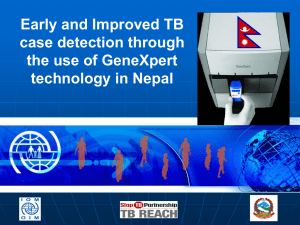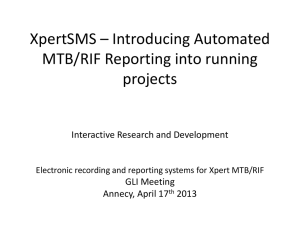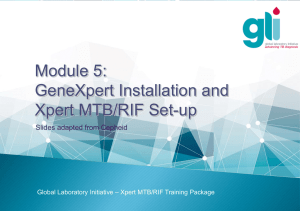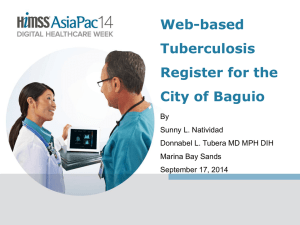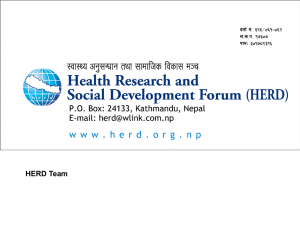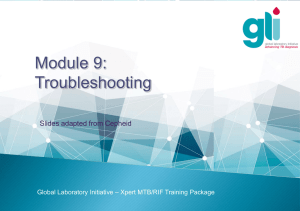Module 02_BIOSAFETY.
advertisement
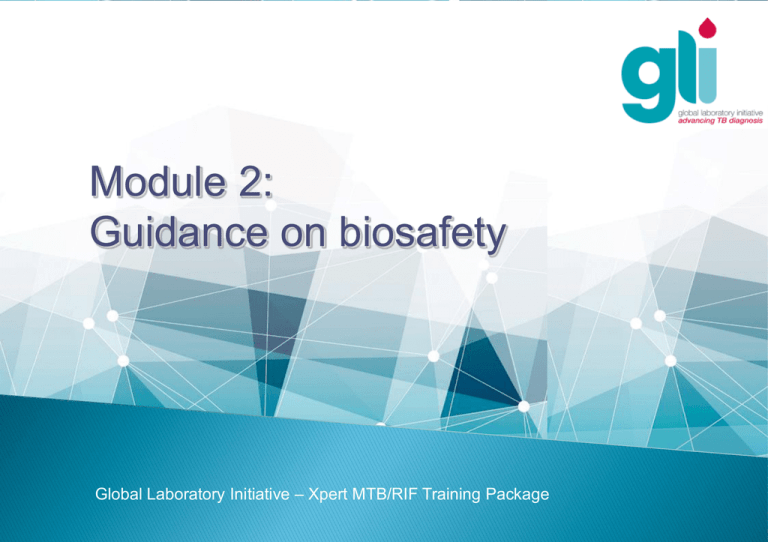
Module 2: Guidance on biosafety Global Laboratory Initiative – Xpert MTB/RIF Training Package Transmission of TB bacilli Risk assessment and precaution levels -2- Safety practices in the TB microscopy laboratory and the Xpert MTB/RIF laboratory Safe disposal of infectious waste Global Laboratory Initiative Xpert MTB/RIF Training Package At the end of this module, you will be able to: Describe the safety risks in laboratories using the Xpert MTB/RIF test Explain what precautions should be taken to safely use Xpert MTB/RIF -3- Global Laboratory Initiative Xpert MTB/RIF Training Package -4- Following laboratory biosafety procedures prevents laboratory staff from becoming infected with TB and prevents microorganisms from being released into the environment ◦ Specialized equipment may aid good laboratory practice but does NOT replace it ◦ Always wear gloves and laboratory coats when handling samples from patients Global Laboratory Initiative Xpert MTB/RIF Training Package The main risks in a TB laboratory are related to the aerosols generated during the procedures that could be inhaled by laboratory workers. The risk of aerosolization is associated with the: ◦ ◦ ◦ ◦ -5- Type of procedure Frequency of testing, and the laboratory’s workload Consistency of the material and its predisposition to aerosolize (for example, viscous liquids versus dry solids) Bacillary load of the materials. Global Laboratory Initiative Xpert MTB/RIF Training Package Higher risk Doctors and nursing staff in TB ward Healthcare workers assisting with specimen collection Lower risk -6- Laboratory technicians processing specimens for smear microscopy or the Xpert MTB/RIF assay Global Laboratory Initiative Xpert MTB/RIF Training Package -7- WHO has adopted an approach that assesses the risks associated with different technical procedures performed in different types of TB laboratories. ◦ Risk-group classifications and containment levels (BSLs) are no longer used. ◦ WHO’s biosafety manual for TB laboratories describes the MINIMUM requirements for facilities, and the practices that can be adopted following a risk assessment (see http://www.who.int/tb/laboratory/resource) Global Laboratory Initiative Xpert MTB/RIF Training Package A risk assessment is simply a careful examination of what in your work could cause harm to people. A risk assessment must consider: ◦ The bacterial load of materials, and the viability of TB bacilli ◦ The route of transmission of TB ◦ Whether the materials handled and the manipulations required for each procedure are likely to generate infectious aerosols ◦ The number of manoeuvres in each technique that may generate aerosols ◦ The workload of the laboratory and of individual staff members ◦ The location of the laboratory ◦ The epidemiology of the disease and the patient population ◦ The level of experience and competence of lab staff ◦ The health of lab staff (especially HIV-positive staff). -8- Global Laboratory Initiative Xpert MTB/RIF Training Package -9- Identify potential hazards. Decide who might be harmed and how. Evaluate the risks and decide on precautions: − Determine the suitability of the physical space − Evaluate the staff’s proficiency in following safe practices − Evaluate the integrity of safety equipment. Record your findings and implement any necessary changes. Review your assessment and update it when necessary. A risk-assessment tool is available at http://www.gliquality.org/ Global Laboratory Initiative Xpert MTB/RIF Training Package Risk level of TB laboratory Low risk -10- Laboratory activities Preparing specimens for smear microscopy or Xpert MTB/RIF testing Assessment of risk Procedures have a low risk of generating infectious aerosols from specimens; the concentration of infectious particles is low Global Laboratory Initiative Xpert MTB/RIF Training Package Risk level of TB Laboratory laboratory activities Assessment of risk Moderate risk Procedures have a moderate risk of generating infectious aerosols; the concentration of infectious particles is low to moderate -11- Processing and concentrating specimens for Xpert MTB/RIF testing or inoculation onto primary culture media; splitting specimens; direct DST (for example, LPA on processed sputum) Global Laboratory Initiative Xpert MTB/RIF Training Package Risk level of TB laboratory Laboratory activities Assessment of risk High risk (TB-containment laboratory) Culture manipulation for identification; DST or LPA on cultured isolates Procedures have a high risk of generating infectious aerosols; the concentration of infectious particles is high -12- Global Laboratory Initiative Xpert MTB/RIF Training Package The Xpert MTB/RIF test is a low-risk procedure, and requires the same level of precautions as those used for performing direct AFB sputum-smear microscopy. -13- Work in a well ventilated area. Wear gloves and a laboratory coat at all times when handling samples from patients. In settings with a high burden of MDR-TB, a risk assessment may determine that additional biosafety precautions are required in Xpert MTB/RIF laboratories; these precautions may include the use of N95 respirators or biosafety cabinets (BSCs). Global Laboratory Initiative Xpert MTB/RIF Training Package -14- Add sample reagent to the specimen in a ratio of 2:1. This step inactivates M. tuberculosis bacilli in the sample, significantly reducing the biosafety risk to the laboratory technician. The sample reagent is provided in 8 ml vials. Processing sputum specimens that have a volume greater than 4 ml requires using more than one vial of reagent, splitting the specimen into smaller volumes or concentrating the specimen. Because of the risk of generating aerosols, splitting specimens and handling concentrated specimens must be performed within a certified BSC. Global Laboratory Initiative Xpert MTB/RIF Training Package -15- Smear preparation and staining: [Dirty activity] Processing samples for Xpert MTB/RIF testing, and inoculating cartridges: [Dirty activity] Microscopic examination of stained smears: [Clean activity] Loading cartridges into the GeneXpert instrument: [Clean activity] Record keeping and storage: [Clean activity] Global Laboratory Initiative Xpert MTB/RIF Training Package Adapt according to the NTP’s guidelines in your country -16- Use of bench spaces: The bench used to process specimens for direct sputum-smear microscopy or the Xpert MTB/RIF assay should be separate from areas where specimens are received and from areas where paperwork is completed and telephones are used. Ventilation: When appropriate microbiological techniques are used, direct smear testing and direct processing of specimens for the Xpert MTB/RIF assay may both be carried out on an open bench in an adequately ventilated area. Global Laboratory Initiative Xpert MTB/RIF Training Package Adapt according to the NTP’s guidelines in your country For low-risk procedures natural ventilation should be sufficient, providing that air flows away from the technician and across the work area to the outside. When the climate prevents windows from being opened, consideration should be given to using mechanical ventilation systems, such as an exhaust fan. • Where natural or mechanical ventilation is not practical, ventilated work stations are an optional solution for managing aerosol containment during direct sputum-smear microscopy or Xpert MTB/RIF testing (http://www.aphl.org/aphlprograms/global/D ocuments/GH_2011July_VentilatedWorkstation Guidance.pdf). • A BSC is not essential for Xpert MTB/RIF testing on direct specimens (i.e., specimens that do not require splitting or concentration). -17- Global Laboratory Initiative Xpert MTB/RIF Training Package Adapt according to the NTP’s guidelines in your country -18- Adequate ventilation for TB laboratories is typically described as directional airflow with 6–12 air exchanges per hour (ACH). Directional airflow refers to air moving from clean areas across areas where aerosols may be generated (dirty areas) and then to the outside. Global Laboratory Initiative Xpert MTB/RIF Training Package Adapt according to the NTP’s guidelines in your country Ways to determine whether ventilation is adequate MEASURING AIR VELOCITY DETERMINING AIR DIRECTION -Anemometer Precision instrument Assessments and verifications - Smoke tubes -Vaneometer Simple and affordable Measures air velocity and direction Can be used routinely Courtesy of P. Jensen - CDC -19- Global Laboratory Initiative Xpert MTB/RIF Training Package Adapt according to the NTP’s guidelines in your country Gloves: essential (use gloves that are disposable and powder-free). Lab coats: essential. Respirators: normally not required but ◦ May be needed based on a risk assessment ◦ Must always be included in a spill kit ◦ Recommended respirators are N95 (NIOSH N95) and FFP2 (EN 149:2001). -20- Global Laboratory Initiative Xpert MTB/RIF Training Package Adapt according to the NTP’s guidelines in your country Gloves are required for processing specimens for Xpert MTB/RIF testing. Use disposable powder-free gloves. Wearing gloves may give technicians a false sense of safety: ◦ Regular and thorough handwashing remains essential. To avoid contamination remove gloves before using computer terminals or telephones. DO NOT reuse gloves. DO NOT wear gloves outside the laboratory. -21- Global Laboratory Initiative Xpert MTB/RIF Training Package Adapt according to the NTP’s guidelines in your country Laboratory coats are essential: ◦ Leave coats at the worksite (do not take coats home) ◦ ◦ ◦ ◦ -22- Fasten the laboratory coat when worn Use appropriate size and type DO NOT wear outside of the laboratory Launder at least weekly, and after any overt contamination (do not take the coat home); disinfect before laundering. Global Laboratory Initiative Xpert MTB/RIF Training Package Adapt according to the NTP’s guidelines in your country N95 and FFP2 respirators effectively filter out >94-95% of particles ≥0.3-0.4 µm in diameter. Respirators must be fitted to the face! (Use the FIT-TEST) Respirators protect the wearer from inhaling droplet nuclei (they protect against inhalation). Surgical masks do not protect the wearer against inhaling infectious aerosols. Surgical masks prevent microorganisms spreading from the wearer (they protect others from exhalation). -23- Global Laboratory Initiative Xpert MTB/RIF Training Package A disinfectant is a chemical or mixture of chemicals used to kill microorganisms. Disinfectants are usually applied to surfaces or inanimate objects. Disinfectants may be used before autoclaving for predecontamination treatment. NOTE: Because of the specific cell-wall structure of TB bacilli, they are resistant to most standard disinfectants – that is, quaternary ammonium compounds are ineffective. -24- Global Laboratory Initiative Xpert MTB/RIF Training Package Adapt according to the NTP’s guidelines in your country Select disinfectants that are effective against mycobacteria based on the material to be disinfected. PHENOL 2-5% in deionized water is highly irritating, and caution must be used in preparation. It is preferable to use phenolic derivatives: ◦ Decontaminate equipment, surfaces and items or liquids before disposal (wear gloves) ◦ Prepare the solution daily and leave in contact with the surface for at least 15 minutes to ensure decontamination. CHLORINE (sodium hypochlorite, or bleach with 0.72% active chlorine) is an irritant, and is corrosive to metals and plastics: ◦ It is a general purpose disinfectant; also can be used to soak contaminated items ◦ Allow at least 15 minutes to ensure decontamination ◦ Prepare daily and store in a well-ventilated area (toxic gas). Do not autoclave. ALCOHOL 70% leaves no residue but is volatile and flammable (keep far from open flames): ◦ Use as a disinfectant on skin (follow by washing with soap) and work surfaces (including metals). PERACETIC ACID leaves no residue, but is stable for only 48 hours after preparation: ◦ Rapid action against all microorganisms. -25- Global Laboratory Initiative Xpert MTB/RIF Training Package Diluted solutions should be prepared daily. Store stock solutions according to the manufacturer's recommendations. Use commercial solutions for dirty situations or the worst possible situations (check to be certain that the product is tuberculocidal). NEVER ADD WATER TO ACID ALWAYS ADD ACID TO WATER WATER ACID WATER Results in excessive heat, foaming, splashing! Pour slowly to avoid excessive heat build-up. Fire in BSC: Bunsen burner ignited 70% alcohol used for cleaning Follow national chemical safety guidelines. -26- Global Laboratory Initiative Xpert MTB/RIF Training Package All laboratories handling samples for TB diagnostic testing should have a spill kit containing: - - -27- Instructions (SOPs) for cleaning up spills A large biohazard bag (autoclavable) Suitable tuberculocidal disinfectant, such as hypochlorite (freshly prepared) or phenol-derivatives, stored in opaque bottles Laboratory gowns (disposable) and goggles Box of gloves (different sizes) Respirators (N95 or FFP2) Paper towels, cotton wool or absorbent cloths Soap and chloramine tablets Dustpan Sharps container “DO NOT ENTER” sign. Check the contents of the spill kit regularly and replace items after use or when they have expired. Global Laboratory Initiative Xpert MTB/RIF Training Package -28- All personnel in the laboratory must be trained in the procedures for handling spills. The actions required depend on where the spill occurs: ◦ Outside a BSC ◦ Within a BSC Global Laboratory Initiative Xpert MTB/RIF Training Package Spill outside the BSC (major event) (1 of 2) ◦ Immediately vacate and secure the laboratory, and inform the laboratory manager. ◦ Leave the laboratory’s ventilation or exhaust systems on, including in the BSC. ◦ Do not re-enter the laboratory for at least 1 hour (post DO NOT ENTER signs). ◦ Before re-entering the laboratory, put on clean gloves, a clean laboratory coat and a respirator. ◦ Cover the spill (or spills) with cloths or absorbent paper, and soak the paper with a suitable disinfectant; apply the disinfectant concentrically, from the outer margin towards the centre of the spill. ◦ Allow sufficient time for the disinfectant to act (at least 30-60 minutes) before disposing of any material. -29- Global Laboratory Initiative Xpert MTB/RIF Training Package Spill outside the BSC (major event) (2 of 2) ◦ Collect all containers and clean-up material and place them in the disposal bag provided in the spill kit; tie the disposal bag and place it in a container to be autoclaved (use an appropriate container for sharp objects). ◦ Change gloves if they have been contaminated; dispose of these along with other infectious waste. ◦ Clean and disinfect the area of the spill. ◦ Staff exposed to the spill should be referred for medical advice, and details recorded in the incident logbook. -30- Global Laboratory Initiative Xpert MTB/RIF Training Package Spill within the BSC (1 of 2) ◦ Cover the spill area with cloths or absorbent paper, and apply a suitable disinfectant concentrically – that is, from the outer margin towards the centre of the spill: Any equipment or material that has been splashed must be cleaned (including the interior surfaces and walls of the BSC, or safety buckets) Do not use bleach to disinfect metal parts (it is corrosive). ◦ Allow sufficient time for the disinfectant to act (30-60 minutes) before disposing of any material. -31- Global Laboratory Initiative Xpert MTB/RIF Training Package Spill within the BSC (2 of 2) ◦ Within the BSC, place all containers and clean-up material into the disposal bag provided in the spill kit; tie the bag, and place it in a container to be autoclaved. ◦ Change gloves if they have been contaminated; dispose of these along with other infectious waste. ◦ Staff exposed to the spill should be referred for medical advice, and details recorded in the incident logbook. -32- Global Laboratory Initiative Xpert MTB/RIF Training Package Breakage of tubes inside sealed buckets - -33- Always use sealed centrifuge buckets. Load and unload them in a BSC. Global Laboratory Initiative Xpert MTB/RIF Training Package Adapt according to the NTP’s guidelines in your country At the end of each day, seal contaminated material (such as used All used materials should be sputum containers, transfer pipettes considered to be contaminated! and used cartridges) in a biohazard bag, and autoclave or incinerate or bury it as soon as possible. ◦ Warning: incinerating plastics can release toxins that are harmful to breathe. Decontaminate transfer pipettes using an appropriate disinfectant prior to disposal. If the NTP’s guidelines do not adequately describe the safe disposal of infectious waste, general guidance that can be modified for this slide can be found on page 31 of: http://www.finddiagnostics.org/export/sites/default/resourcecentre/reports_brochures/docs/malaria_rdt_transport_healthclinics_may09.pdf -34- Global Laboratory Initiative Xpert MTB/RIF Training Package -35- The Xpert MTB/RIF test is a low-risk procedure that requires the same level of precautions as those used for performing direct AFB sputumsmear microscopy. The main risks in a TB laboratory are related to the aerosols generated during the procedures that could be inhaled by laboratory workers. The risk of aerosolization is associated with the type of procedure, the frequency of testing, the workload, the consistency of the material and its predisposition to aerosolize (for example, viscous liquids versus dry solids), and the bacillary load of the materials. A BSC is required only when splitting and handling concentrated specimens. Disinfectants should be selected based on their tuberculocidal activity and the material to be disinfected. Ensure that the laboratory is prepared for emergencies and has standard operating procedures for handling accidents such as spills. Global Laboratory Initiative Xpert MTB/RIF Training Package -36- What are the sources of infectious aerosols in a TB laboratory? What precautions must be taken when handling specimens for performing Xpert MTB/RIF testing (direct and indirect)? What additional safety precautions are needed to perform Xpert MTB/RIF testing compared with smear microscopy? What are the critical items and equipment needed to safely process specimens? What are the most effective disinfectants in TB laboratories? What procedures should be followed when coping with accidents? What are the contents of a spill kit? What are the steps for safely disposing of infectious waste? Global Laboratory Initiative Xpert MTB/RIF Training Package Acknowledgements The Xpert MTB/RIF Training Package has been developed by a consortium of GLI partners, including FIND, KNCV, US CDC, USAID, TB CARE I and WHO, with funding from USAID. The modules are based on materials originally developed by FIND, KNCV and Cepheid.
